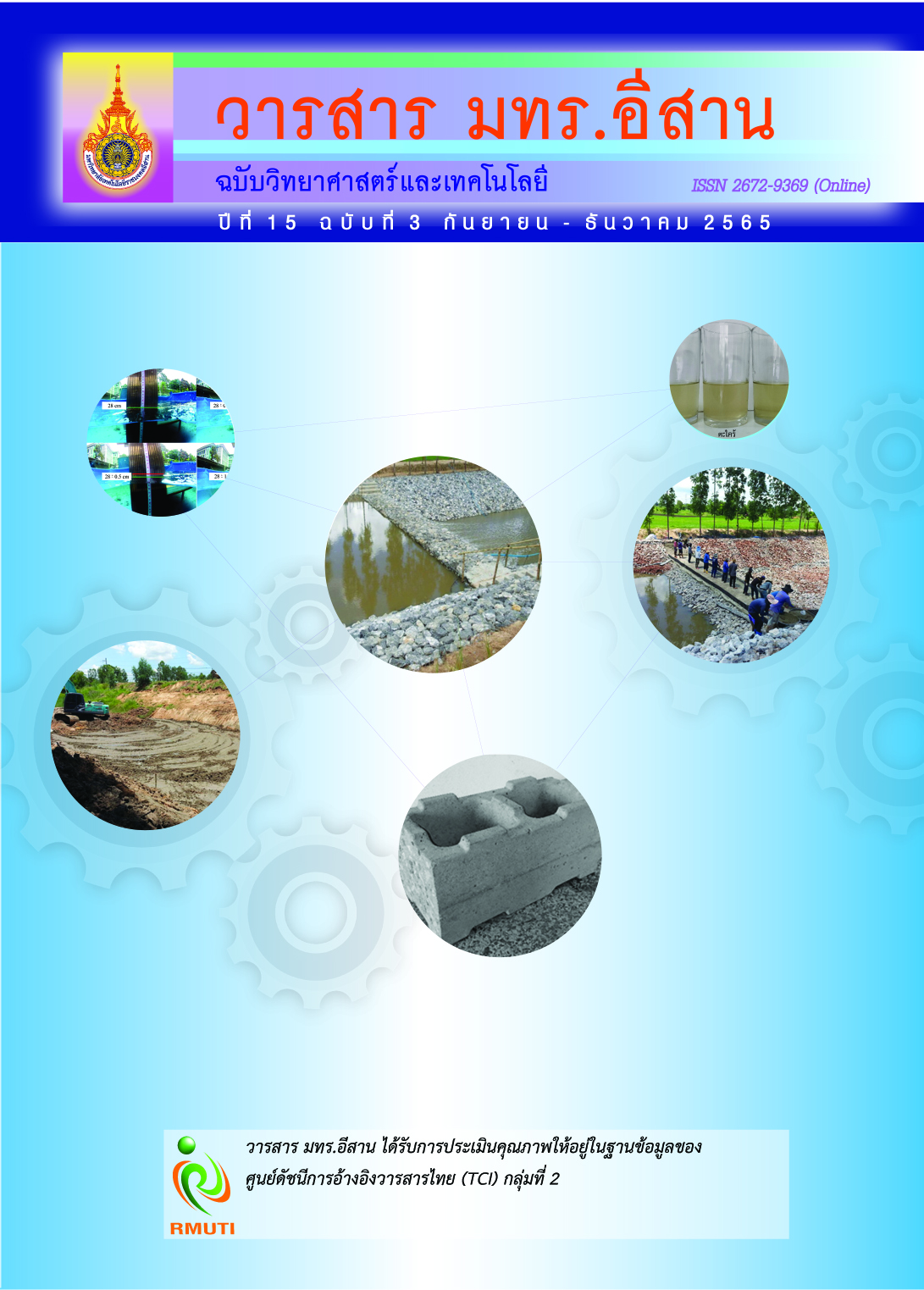The Effect of Surface Waves on Power Conversion Efficiency of Underwater Solar Panels
Main Article Content
Abstract
This work reports the effect of surface waves on the power generation of solar panels. The experiments were carried out to determine the optimal wave characteristics for solar panels to generate maximum power when installed under water at the depth of 1 cm. Several electrical parameters were obtained under natural sunlight and ambient conditions for the comparison. The results were used to create a mathematical model which was used to predict the annual power generation of underwater solar panels. The key parameters employed in the prediction of the annual solar power generation included solar radiation, ambient and panel temperature. The results revealed that the solar panel installed underwater with surface wave height of 0.3 cm showed the highest power conversion efficiency of 24.06 %, compared to 12.78 % from the one installed on land. The annual power generation of an installed underwater solar panels with the surface wave height of 0.3 cm and capacity of 1 MW was estimated, by a mathematical model, to provide an yearly income of 9,804,636 THB, which was 227,059 THB higher than that from the on-ground installation system.
Article Details

This work is licensed under a Creative Commons Attribution-NonCommercial-NoDerivatives 4.0 International License.
References
Wang, M. -H. and Chen, M. -J. (2012). Two-Stage Fault Diagnosis Method Based on the Extension Theory for PV Power Systems. International Journal of Photoenergy. Vol. 2012, DOI: 10.1155/2012/892690
Nižetić, S., Čoko, D., Yadav, A., and Grubišić-Čabo, F. (2016). Water Spray Cooling Technique Applied on a Photovoltaic Panel: the PerformanceResponse. Energy Conversion and Management. Vol. 108, pp. 287-296. DOI: 10.1016/j.enconman.2015.10.079
Moharram, K. A., Abd-Elhady, M. S., Kandil, H. A., and El-Sherif, H. (2013). Enhancing the Performance of Photovoltaic Panels by Water Cooling. Ain Shams Engineering Journal. Vol. 4, Issue 4, pp. 869-877. DOI: 10.1016/j.asej.2013.03.005
Abdo, S., Saidani-Scott, H., Borges, B., and Abdelrahman, M. A. (2020). Cooling Solar Panels Using Saturated Activated Alumina with Aaline Water: Experimental Study. Solar Energy. Vol. 208, pp. 345-356. DOI: 10.1016/j.solener.2020.07.079
Ajitha, A., Kumar, N. M., Jiang, X. X., Reddy, G. R., Jayakumar, A., Praveen, K., and Anil Kumar, T. (2019). Underwater Performance of Thin-Film Photovoltaic Module Immersed in Shallow and Deep Waters Along with Possible Applications. Results in Physics. Vol. 15, p. 102768. DOI: 10.1016/j.rinp.2019.102768
Rosa-Clot, M., Rosa-Clot, P., Tina, G. M., and Scandura, P. F. (2010). Submerged Photovoltaic Solar Panel: SP2. Renewable Energy. Vol. 35, Issue 8, pp. 1862-1865. DOI: 10.1016/j.renene.2009.10.023
Pelikán P. and Koutný L. (2016). Hindcast of Wind Driven Wave Heights in Water Reservoirs. Soil & Water Res. Vol. 11, pp. 205-211. DOI: 10.17221/105/2015-SWR
Fauzi, R. and Wiryanto, L. (2020). The Effects of Wind on the Generation of Surface Wave in a Shallow Water. IOP Conference Series: Earth and Environmental Science. Vol. 618, p. 012003. DOI: 10.1088/1755-1315/618/1/012003
TDETlab. (2019). Mathematical Modeling Program for Solar Hot Water Production System. Access (10 December 2021). Available (http://www.tdetlab.com/publication)
Northern Meteorological Center. (2018). Chiang Mai Climate Statistics. Access (10 December 2021). Available (http://www.cmmet.tmd.go.th)
Chaichana, C., Kiatsiriroat, T., and Nuntaphan, A. (2010). Comparison of Conventional Flat-Plate Solar Collector and Solar Boosted Heat Pump Using Unglazed Collector for Hot Water Production in Small Slaughterhouse. Heat Transfer Engineering. Vol. 31, Issue 5, pp. 419-429. DOI: 10.1080/01457630903375475
Hao, D., Qi, L., Tairab, A. M., Ahmed, A., Azam, A., Luo, D., Pan, Y., Zhang, Z., and Yan, J. (2022). Solar Energy Harvesting Technologies for PV Self-Powered Applications: A Comprehensive Review. Renewable Energy. Vol. 188, pp. 678-697. DOI: 10.1016/j.renene.2022.02.066
Rosa-Clot, M., Rosa-Clot, P., Tina, G. M., and Scandura, P. F. (2010). Submerged Photovoltaic Solar Panel: SP2. Renewable Energy. Vol. 35, Issue 8, pp. 1862-1865. DOI: 10.1016/j.renene.2009.10.023
Zanatta, A. R. (2022). The Shockley-Queisser Limit and the Conversion Efficiency of Silicon-Based Solar Cells. Results in Optics. Vol. 9, p. 100320. DOI: 10.1016/j.rio.2022.100320


